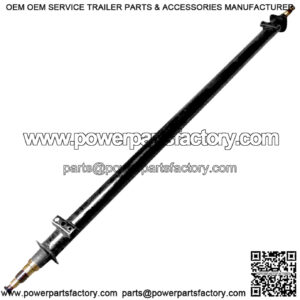An axle is an essential component of the trailer to support the chassis. It allows safe driving by supporting the wheels of the trailer.
Composed of shock absorbers, bearings, and a hub, the metal shaft is placed under the body, to support the wheels.
The choice of an axle is made by referring to the permissible gross weight. Linking the unsprung elements and suspended mass, the suspension prevents wear and mechanical fatigue, while improving the comfort of driving.
They differ according to the brands and models of trailers.
Braking vs Unbraked
Thus one can have braking axes (equipped with a braking system) and unbraked axes (no brake).
For the Daxara brand, for example, there are several models of axles according to the legal PTAC.
With a strength ranging from 400 to 1500 kg, Daxara products have the advantage of strengthening and improving the strength of chassis.
Whether baggage trailers, bike racks (our full range here) or bike racks, Daxara offers durable axles to keep users safe.
The braked axles are equipped with an inertia brake system consisting of a sliding drum, a transmission system, wheel brake, linkage and brake cables, to secure the trailer (avoidance of skidding, stoppage systematic, etc.).
The unbraked axles are not equipped with a braking system. In this case, the trailer is stopped by the braking of the towing vehicle. The half axles, are designed to support identical loads, except that they have the advantage of being adaptable to the dimensions of your trailer.
Trailer axle: what’s the point, how to choose it?
An essential component of a trailer, the axle supports its load and keeps the wheels. His choice is based on the weight to tow and conditions the good handling of the team.
The question of the PTAC
Gross Vehicle Weight (GVW) is the starting point for choosing a trailer axle. It indicates the maximum weight that can reach a trailer with its load.
With a B license, the GVWR must be less than 750 kilograms. It may exceed this if it is less than the weight of the car and the total weight of the trailer, load and car does not exceed 3.5 tonnes.
The PTAC of a trailer will, therefore, be higher on heavy cars such as SUVs.
With Or Without braking?
Trailer axles can have their own braking system. It is mandatory on trailers with a GVWR of more than 750 kg and when the trailer GVW exceeds half the unladen weight of the towing vehicle. These are inertial braking systems with linkage and cables. They ensure a better handling of the couple trailer – car and avoid skidding of the hitch
Single Or Half?
Know that there are half axles trailer. More expensive than simple models, they have the advantage of adapting to all types of trailers. The half-axles are also able to support the same loads as the single axles.
Price Considerations
Trailer axle prices vary according to the load they have to bear and the presence or absence of a braking device. Count a minimum of 150 euros for a simple model for a small trailer (450 kg) and up to 2000 euros for a pair of braked half-axles that can support a heavier load (up to 2000 kg). The tariffs for single braked axles start at around 500 euros (for a gross weight of 750 kg).
Braked Versions?
A braked shaft is provided with a braking system. In most cases this is the traditional drum brake. There are also axles with a hydraulic brake system or disc brakes. But since these systems are much more expensive than the drum brakes and often require adjustments of the towing vehicle, this is not often used in the assembly of new trailers.
The overrun brake and braking system of brake cables press the overrun brake during braking so that the brake cables pull the brake shoes against the brake drum and thus the trailer brakes itself. If the pressure then drops on the overrun brake, the brake shoes will also release the grip on the drum. A braked shaft is thus provided with a brake drum with the associated brake shoes already mounted there. The axle is also always delivered with the corresponding wheel bolts.
What Is An Unrestrained Shaft?
An unrestrained axle for a trailer is an axle with bearings but without a drum brake. The braking effect must come entirely from the towing vehicle.
That is why the maximum gross payload of an unrestrained trailer is often not higher than 750 kg up to a maximum of 1050 kg because otherwise, the load on the towing vehicle is too great.
What is allowed depends on the car and is mentioned in the registration certificate. There are also unrestrained shafts with waterproof bearings. This is especially useful when you have a boat trailer that often drives into the water.
What Is A Torsion Shaft?
A torsion axle is the most commonly used axle by trailer manufacturers and means no other than a rubber axle.
The suspension is in the axle body itself. Another variant is for example leaf suspension. You still see this a lot in England. A torsion shaft is recognizable on the arm that secures the shaft profile of the shaft to the brake drum. Here you will find our range of torsion axles.
Replacing Torsion Shafts
First of all, it is important to know why you want to replace the axle. Is the swivel arm bent or should the shaft rubbers be replaced?
Always choose the same Axle brand as what is already underneath to guarantee the operation of the brakes.
Detecting Crooked Swivel Arms
You can see this clearly when you disassemble wheels from the shaft. It is then important to measure the angle of the axis as shown diagrammatically in the figure below. If the angle is less than 20 degrees, the axis is curved. Replacing is then a better and often even cheaper solution than repairing.
Replacement Considerations
Then there are a few important technical terms that you need to understand to know which axis you need. What is the pad size of an axle of a trailer?
The pad size is the distance from the heart at a distance from the axis of the shaft. See the drawing below. The pad size is the most important dimension for the axle if you want to replace it.
What is the track width of an axle?
The track width is the intermediate distance to the center of both tires. Depending on the ET value, the rim determines whether it is more inward or outward.
What is the Flange Size of an Axis?
In addition to the pad size, the flange size is also important. Often this is a standard size from the pad size (450mm) but not always. So be sure to know that you have ordered the correct shaft, measure = know! The flange size is the distance between the two outer sides of the brake drum. Measured from the flat outside, so without wheel bolts and hubcap!
About Trailer Axle
“trailer axle”
“trailer axle kit”
“trailer axle for sale”
“trailer axle parts”
“trailer axle weight limit”

